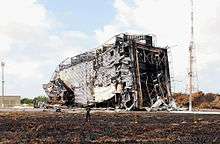VLS-1 V03
 Wreck of the structure of the VLS launch pad | |
| Time | 13:26:05 between frames 26 and 27 BRT (UTC-3) |
|---|---|
| Date | 22 August 2003 |
| Location | Alcântara Launch Center, Maranhão, Brazil |
| Outcome | Setback to the Brazilian space program with the loss of 21 technicians, launch vehicle and structure (launch pad and launch tower) |
| Deaths | 21 |
The 2003 Alcântara VLS accident was an accident involving a Brazilian Space Agency VLS-1 launch vehicle, which was intended to have launched two satellites into orbit. The rocket exploded on its launch pad at the Alcântara Launch Center, killing 21 people. This was the third attempt by the Brazilian Space Agency to launch the VLS rocket into space.
Accident
On August 22, 2003, at 13:26:05 between the frames 26 and 27 [1] (local time) an inadvertent propellant ignition [2] destroyed the launch vehicle as it stood on its launch pad at the Alcântara Launch Center in the state of Maranhão in northern Brazil. Twenty-one people, standing on the launch pad, died when one of the rocket's four first stage motors ignited accidentally.[3] The explosion caused a fire in the nearby jungle brush, and produced a large cloud of smoke that was visible for large distances.
Aftermath
The explosion leveled the rocket's launch pad, reducing a 10-story high structure to a pile of twisted metal. The rocket had been scheduled to launch in just a few days' time and had two satellites on board when the explosion occurred.
After the explosion, the Brazilian Space Agency was criticized for using solid-fuel rockets, which are easier to build and ignite than liquid-fuel rockets, but also dangerous because they lack throttle controls and emergency shut-offs.[4] The incident has caused a significant delay to the Brazilian space program because of government inquiries as well as the fact that many scientists and engineers who worked on the program died when the rocket exploded.[5]
An investigation by the Brazilian Government after the explosion found "dangerous buildups of volatile gases, deterioration of sensors and electromagnetic interference" at the launch site.[6]
See also
References
- ↑ https://dallapiazza.wordpress.com/2013/10/01/analise-tecnica-do-relatorio-da-investigacao-do-acidente-ocorrido-com-o-vls-1-v03-em-22-de-agosto-de-2003-em-alcantara-maranhao/
- ↑ https://dallapiazza.wordpress.com/2013/10/01/analise-tecnica-do-relatorio-da-investigacao-do-acidente-ocorrido-com-o-vls-1-v03-em-22-de-agosto-de-2003-em-alcantara-maranhao/
- ↑ http://www.spacetoday.org/Rockets/Brazil/BrazilRockets.html
- ↑ http://www.flightglobal.com/news/articles/ignition-fault-probed-in-brazil-blast-170779/
- ↑ Plano Brazil. Retrieved on 2013-12-19.
- ↑ Space program management contributed to rocket explosion Red Orbit. Retrieved on 2012-03-06.
External links
- FSP: New tests postpone VLS-1 V04 launch (in Portuguese)
- BBC: A scaled down VSV-30 launch successfully
- BBC: Fatal blast hits Brazil space hopes
- BBC: Brazil vows to pursue space plan
- SpaceDaily article on explosion
Coordinates: 2°22′23″S 44°23′47″W / 2.37306°S 44.39639°W